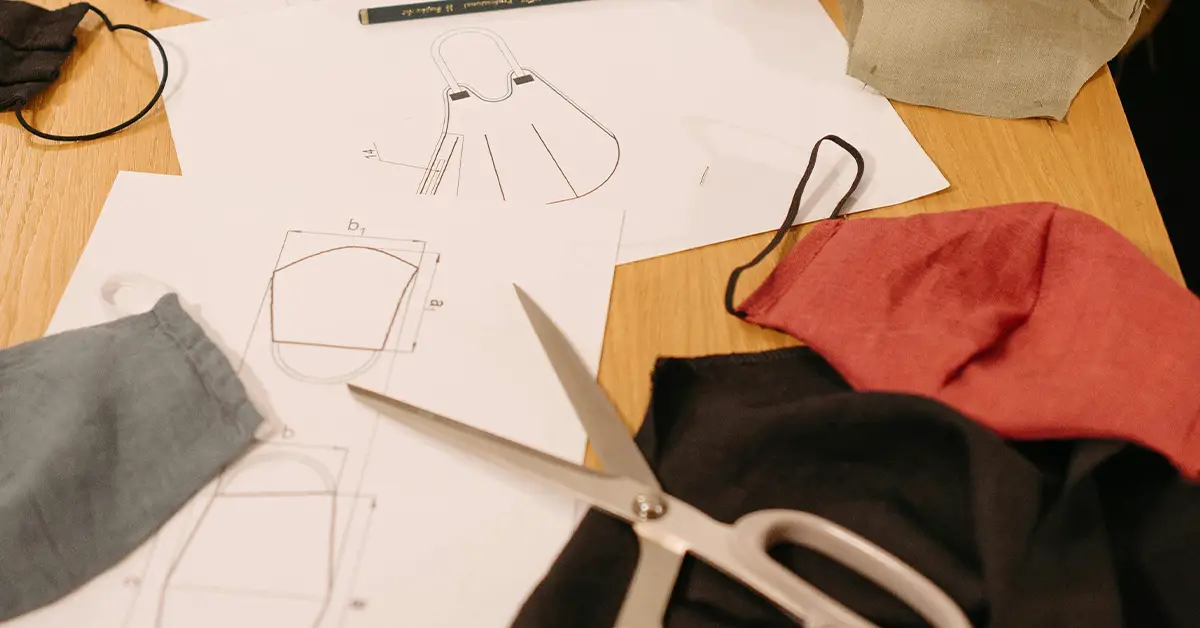Sewing is the technique and process or the craft of attaching objects with stitches using yarn or thread and a needle. While stitching is the procedure of looping thread or yarn to link two things jointly.
Craftsmanship is the oldest industry worldwide and is still practiced by people who love artistic works. Interest, good patience, ideas, and drive to learn are needed to become a successful craftsman. Excellent skills are achieved through experience plus many years of practice and study. Here we talk about the difference between stitching and sewing, main types, and touch on their basics.
The Significant Difference Between Stitching And Sewing
| Stitching | Sewing |
| A loop of thread or yarn is sufficient for stitching. | Yarn or thread and a needle are needed in the case of sewing. |
| Stitching is not an old concept. | Sewing was there and used by the people in the Paleolithic age |
| Stitching can be of seven types, i.e., cross, knot, back, running, overcast, chain, and buttonhole | Sewing has three varieties, mainly plain, fancy, or heirloom. |
| Stitching is the essential element of sewing, knitting, embroidery, quilting, or any other needlework. | Sewing is a craft which existed since the ancient period. It’s the foundation of patchwork, embroidery, and tapestry. |
| Stitching is the process of joining objects or things | Sewing is a craft. |
What Is Stitching In Sewing?
In the textile art industry, a stitch refers to a loop or a single turn of yarn or thread. They are the fundamental component of sewing, embroidery, quilting, needle lace-making, and knitting; it doesn’t matter if it’s by machine or hand. Different stitches, having one or more names, are used for a particular purpose.
These stitch names differ according to the needle position, sewing direction, the shape or form of the stitch, and purpose.
What Are The 7 Basic Stitches?
Getting started on embroidery involves creativity, originality, uniqueness, passion, and skill for stitches’ divergent ideas. Plus, how it’s applied in textile artistry. Learning is fun and relaxing though it may seem intimidating; when you get the basics, the journey will be more enjoyable. There are basic stitches like running, cross, knot, back, overcast, buttonhole and chain stitching,
Running Stitch
It’s known to be the basis of popular Japanese sashiko embroidery. It’s the simplest embroidery stitch suitable for making dashed outlines while adding details to embroidery by flossing the needle in and out of your fabric to create spaces and lines of thread. However, it can become complex, especially for spacing, length, or adding row stitches in-between the first line. They are pretty well at wrapping and weaving.
Chain Stitch
If you want to make your stitch slightly artistic, intermediate, and bolder line, then it’s time to try chain stitch. This type of stitch stands out due to the row of linked stitches. It’s similar to loop to loop technique since one makes series of loops that interlink to one other. You can use it in different designs and illustrations because it’s flexible on any edges. Plus, it’s an excellent way to learn how to work it forward and in reverse.
Backstitch
It’s pretty easy to learn backstitches within few stitches. It’s the standard stitch people use around because it’s helpful in any outlining. Backstitch pairs well with other stitches, which makes it a key stitch to learn. The stitch is done from the left to the right whereas, the basic stitching begins from right to left. That’s is literally where the name came from, use it and display the image you desire.
Buttonhole Or Blanket Stitch
The beginning is the trickiest part of these stitches, though it’s a valuable technique that forms borders and beautiful edges. It also secures your embroidery edges. To keep your neat textile, remove any unwanted threads. Then adjust the height and spacing of the stitches to add variation to your embroidery.
Cross-Stitch
It’s a form of sewing that’s common that has counted thread embroidery in x-shape stitches and array-like tiles. It has been there for ages and is generally used for decorative purposes.
Overcast Stitch Or Whipstitch
Overcast stitch is particular stitch use for edge finishing, and it can be sewn by hand or a sewing machine. For neat and decorative edges, use an overcast stitch on your fabric. It also prevents the unraveling of raw edges on your material and quickly eliminates frayed fabric edges.
Knot Stitch
Making French knots remain a challenge to several people. Although it may take you time to learn, it’s worthwhile in the end. Apart from being famous, it’s also a good stitch to use when creating a textured fill or other design components. To make a stitch, wrap the needle to form a knot on the fabric area. The trickiest part with these knots is to hold the working thread taut tight but not that tight. Give it time and practice more; the result is worth your efforts.
What Are The Types Of Sewing Machines?
The sewing machine is classified into two, i.e., domestic machines used in homes and industrial machines used in factories for cloth production. They are countless machines specifically for industrial while there are six types of domestic sewing machines as discussed below:
1. Mechanical sewing machines are the most basic machines that can operate manually or tread, suitable for beginners. They only stitch straight stitches by turning the wheel to drive the needle to make them.
2. Automated and computerized machines– are fully automated and computerized with LCD. You can make buttonholes and built-in stitches though they are costly.
3. Embroidery Machines– it has a memory facility to store designs as well as access to built-in designs. It’s expensive but a good investment for someone planning to make lots of embroideries.
4. Quilting Machines have longer arms that enable more significant volumes of fabric to pass via the device. It can sew thicker fabrics and can make large quits.
5. Overlocking Machines- it’s suitable for sewing fleece for sportswear and stretch knits. It has three or four threads and can sew, oversew, trim the edges of seams.
6. Electronic Machines- it’s the combination of the computerized and manual sewing machine. It has many features and is mainly used by experts.
What Is The Strongest Stitch?
Many sewing machines have around 10 to 30 types of stitches, and people usually ask themselves which is the strongest of all. Based on our research, a straight stitch is hard to tear, and if combined with durable and tough nylon or polyester thread, the result is excellent. Meaning a straight stitch is the strongest due to how its stitch will layer the fleece.
There will be multiple layers of thread on top of one another, thus giving a solid and excellent result. If one tries to tear it, they need to pull many threads at once. It’s close to impossible to tear much fabric across the stitch. If one from a different end, they have the extra layer to keep it together.
The most robust hand-made stitch remains the super-durable backstitch since it enables one to go over every area twice. You need to stick the needle across the fabric and create a loopback, as the name suggests. Afterward, loopback and then move two stitches forward before going back again and continue. To achieve all these, you need a tough thread and fabric.
Why Is It Important For Children To Learn The Basic Hand-Sewing Stitches?
Teaching your children to sew will have a positive effect on their mental growth and character development. Allow them to sew back their buttons, make a lovely gift to someone or fix toys. It will provide physical, mental, and educational benefits in a fun and exciting way. Furthermore, it can become a valuable skill even in their adult lives.
Check below more benefits of sewing in your children;
Develop Their Motor Skills Well
Sewing helps your kids develop fine motor skills appropriately since the process needs precise and gentle hand movement, which is necessary when playing, writing, or using some tools. Lack of motor skills makes their hand coordination very rough. Children who practice sewing understand their fingers correctly and move their hands precisely while holding or using small items with ease. The most significant part is that one can teach their kinds with just a piece of fabric, a needle, and thread.
Help Them Build Self-Confidence And Confidence In Their Skills
Mastering new skills can remarkably improve their self-confidence. Simply because kids will seek praise and acknowledgment when they achieve something. When they make something on their own, sewing can give them that sense of accomplishment. Which in turn assist them to build up their self-confidence.
Learn To Be Patient
Most kinds lack patience, especially when they need something right away. Teaching them that it’s not always possible to get what they want is pointless. But when they learn on their own, they will understand its importance. Sewing can be a better and effective way to teach them. The process will instill all these since they will need to wait for a while before achieving the results.
Help Them Follow Instructions While Practicing Communication
Since they can’t learn independently, they will need someone to teach and explain to them. At first, kids might ignore your words, but eventually, they will understand the importance of listening and following instructions. Later they will be seeking clarification on various things. In the end, they will understand the need to express their thoughts precisely and efficiently always.
Help Children To Make Use Of Their Imagination And Creativity
Kids can use their powerful imagination and creativity to come up with something good while sewing. With your help, they can come up with fascinating and unique ideas that will even surprise you. Give them that opportunity, and they will always be able to come up with new imaginations when dealing with other things in their lives.
Conclusion
As mentioned earlier, stitches are the fundamental component of sewing, embroidery, knitting, etc. Sewing can be done by hand or using machines. It needs passion, patience, practice, and drive to learn different types of stitches over time. Creativity and imagination bring out your skills ideally in your work. Be patient! Practice makes it perfect.

